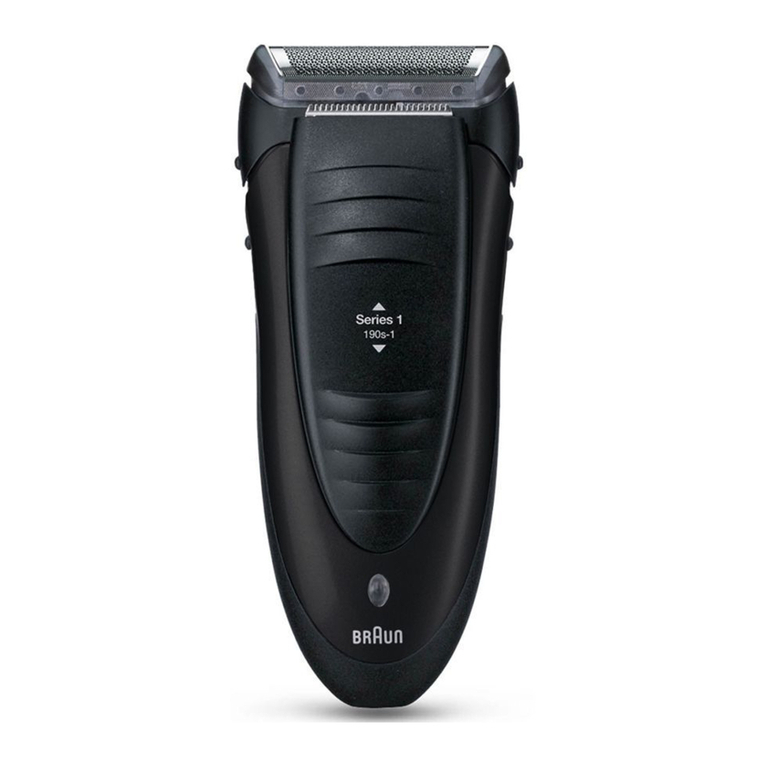PEUGEOT PARTNER ELECTRIC User manual


You can find your user guide on the PEUGEOT website, under the
heading "Personal space". Referring to the user guide on-line also gives you access
to the latest information available, easily identified by the
bookmarks, associated with this pictogram:
If the heading "Personal space" is not available on the public website
for your country, you can find your user guide at the following address:
http://public.servicebox.peugeot.com the link in "Private customer access",
the language,
the model,
the edition date appropriate for the date of registration of your vehicle.
Select:
You will find your user guide, presented in the same way as the paper version.

1
This new vehicle has been designed to satisfy all your
requirements in terms of practicality, comfort, safety
and aesthetics. In order to get the most out of your
vehicle, we suggest that you take a tour, from the
cab to the load space, with the "Handbook" in front
of you. The handbook presents the operation of the
equipment available on board in detail.
WELCOM
E
Your vehicle is fitted with only some of the equipment
described in this document, depending on its trim level,
version and the specification for the country in which it
was sold.
Please note the following point: the fitting of electrical
equipment or accessories which are not recommended
by PEUGEOT may result in a failure of your vehicle's
electronic system. Please note this specific warning. It is
advisable to contact a PEUGEOT dealer to be shown the
recommended equipment and accessories.
PEUGEOT thanks you for your confidence and wishes
you very happy motoring.
For any work on your vehicle, use a qualified workshop
that has the technical information, competence and
equipment required, which a PEUGEOT dealer is able to
provide.

2
Contents
K
e
y
1
7
Re
m
o
t
e
co
ntr
o
l
1
7
D
oo
r
s
2
0
R
ear roof fla
p
2
4
Tail
g
ate
2
5
C
entral lockin
g
2
6
Instrument
p
anel
2
7
Ad
j
ustin
g
the time
2
8
W
arnin
g
lamps
2
9
Fuel
g
au
g
e
3
5
C
oolant
3
5
T
y
re under-in
fl
ation
detection
3
6
S
ervice indicator
3
7
L
i
g
htin
g
rheostat
3
8
G
earbox
3
9
G
ear shi
f
t indicator
3
9
6
-speed electronic
g
earbox s
y
stem 4
0
S
teerin
g
wheel
a
d
j
ustment 4
2
S
to
p
& Start 4
3
S
tartin
g
and stoppin
g
4
6
H
ill
s
t
a
rt
ass
i
s
t 4
7
Li
g
htin
g
co
ntr
ol
4
8
wipers
5
1
C
ruise control
5
3
S
peed limiter
5
6
H
eatin
g/
Manual
air conditionin
g
5
9
automatic 6
1
D
e-icin
g
and demistin
g
6
3
Front seats
6
5
I
n
di
v
id
ua
l
passen
g
er
sea
t
6
6
M
ulti-Flex bench seat
6
7
C
on
fi
g
urations 6
9
Front
fi
ttin
g
s
7
0
C
ourtes
y
li
g
hts
7
2
C
rew cab
7
3
Load space
7
5
Roo
f
ba
r
s
7
7
Mi
rr
o
r
s
7
8
Toll cards
/
car park
ti
c
k
e
t
s
7
9
E
lectric windows
8
0
Pr
ese
nt
a
ti
o
n
4
E
xt
e
r
io
r
6
In
s
tr
u
m
e
nt
s
a
n
d
co
ntr
o
l
s
8
C
entre console
9
S
ittin
g
com
f
ortabl
y
1
0
S
eein
g
clearl
y
1
1
Drivin
g
safel
y
1
1
C
ab space
1
2
Load space
1
3
Ve
ntil
a
ti
o
n
1
4
Eco-drivin
g
1
5
H
azard warnin
g
lamps
8
1
Parkin
g
brake
8
1
Parkin
g
sensors
8
2
A
nti-lock brakin
g
sy
stem
(
ABS
)
8
4
E
mer
g
enc
y
b
ra
ki
n
g
ass
i
s
t
a
n
ce
8
4
Traction control
(
ASR
)
and
s
tabilit
y
control
(
E
S
P
)
8
5
"
G
rip control"
8
6
S
eat belts
8
9
A
irba
g
s
9
1
Passen
g
er airba
g
deactivation
9
4
C
hild seats
9
5
Reco
mm
e
n
ded
sea
t
s
9
7
Installin
g
child seats
usin
g
the seat belt
9
8
2
. READY TO SET OFF
17
-
47
4
. SAFETY
81-99
1
. FAMILIARISATION
4-1
6
3
. EASE OF USE and
COMFORT 48-8
0

3
Contents
CONTENT
S
E
mer
g
enc
y
or
ass
i
s
t
a
n
ce
9.
1
P
eu
g
eot Connect
Navi
g
ation
(
RNE
G)
9
.
3
P
eu
g
eot
C
onnect
S
ound
(
RD5
)
9.3
7
Towin
g
a trailer 1
0
0
O
ther accessories 1
0
1
Trade ran
g
e
10
1
Telematic unit 1
0
2
O
penin
g
the bonnet 1
0
4
Petrol en
g
ine 1
0
5
Diesel en
g
ine
10
6
Levels 1
0
7
C
hecks 1
0
9
F
ue
l
11
1
C
ircuit disarmed 1
1
2
Diesel reprimin
g
pump 1
1
2
B
atter
y
11
3
C
han
g
in
g
a wheel 1
1
5
Re
m
o
v
able
s
n
o
w
sc
r
ee
n
11
9
C
han
g
in
g
a
bu
l
b
1
2
0
a
fuse
1
2
5
a
windscreen wipe
r
b
l
ade
1
2
9
B
ein
g
towed
13
0
Dimensions 1
3
2
W
ei
g
hts
13
7
Identification markin
g
s 1
3
8
E
xterior 1
3
9
I
n
s
tr
u
m
e
nt
s
a
n
d
co
ntr
o
l
s
1
4
0
Int
e
ri
o
r 14
2
Tech
n
ical
da
t
a
-
Ma
int
e
n
a
n
ce
1
4
3
9
. TECHNOLOGY on
BOARD
5. ACCESSORIE
S
100-102
7. QUICK HELP
113-13
1
10. VISUAL SEARCH
139-14
4
6. CHECK
S
103-112
8
.
T
ECHNICAL
DATA
132-13
8
PC: Peugeot Connect is the
name given to all of the new
equipment of the radio/
navigation range.
The "Technology on board"
section presents the new
radio/navigation systems.
The "Location" section
assists you in finding the
controls and functions
and their associated page
numbers on the schematic
outlines of the vehicle
(visual index).

4
PRE
S
ENTATION
Within the chapters, symbols draw your attention to specific
information:
This handbook has been designed to familiarise you with
your new vehicle from the moment you get behind the
wheel and to describe the operating features.
Reading the handbook is made easy with the content
consisting of 10 identified chapters, which can be located
by means of a colour code specific to each one. Its
sections cover, by subject, all of the functions of the
vehicle in its most complete specification.
Chapter 8 gives all of the technical data relating to your
vehicle. At the end of the document, diagrams of the
outside and inside of the vehicle will assist you in locating
equipment or functions and page numbers refer you to
the relevant section of the handbook.
directs you to the chapter and section which contains
detailed information concerning a function,
indicates important information relating to use of
the equipment,
alerts you to the safety of individuals and equipment on
board.

5

2a
6
2b
5
2e
7b
2c
7a
4
2d
8
4
6
Exterior

2c
2e
2b 7a4
5
7b
2a 6
5
82d
7
1
FAMILIARISATION
Exterior
17
22
25
Key
: chapter identification
: page identification
82
86
Grip control Changing bulbs
120
104
Opening the bonnet
Parking sensors
Business equipment - Accessories
101
21
Key - Remote control
Side-hinged rear doors
Sliding side door
Tailgate and rear screen
Useable dimensions
132
Spare wheel
115
24
Rear roof flap

8
Interior
INSTRUMENTS AND CONTROLS
1. Lights and direction indicator
stalk.
2. Instrument panel with screen.
3. Wipers, screenwash, trip
computer controls.
4. Ignition.
5. Audio controls.
6. Driver's airbag, horn.
7. Steering wheel height and reach
adjustment.
8. Cruise control, speed limiter
switches.
9. Switch panel, parking sensors,
headlamp beam adjustment,
ESP, Stop & Start.
10. Bonnet release.
11. Electric door mirror adjustment.

4
2
9
9
1
FAMILIARISATION
Interior
CENTRE CONSOLE
1. Switch panel: electric
windows.
2. Switch panel: hazard warning
lamps, central locking
(passenger compartment, load
space).
3. Cigarette lighter.
4. Heating-ventilation
controls.
5. Storage compartment.
866. Grip Control.
7. Audio system.
8. Screen.
40
9.110. Emergency or
assistance call.
9. Electronic
gearbox gear
selector

3
43
2
3
10
Interior
1.
Forwards-backwards
adjustment.
2. Angle.
3. Height. 4. Head restraint
height and
angle.
Driver's seat
65
71
42
78
89
SITTING COMFORTABLY
Steering wheel
Adjust the steering wheel for height
and reach.
Storage compartments
These are placed under the front
seats. For greater ease, reach behind
the seat to access them.
The tools are stored under the right-hand
seat and can be accessed from the rear.
Seat belts
Height adjustment.
Fastening.
Mirrors
Manual adjustments.
Electric adjustments.

3
3
3
3
9
3
11
FAMILIARISATION
Interior
Lighting off.
Sidelamps.
Dipped beam headlamps (green).
Main beam headlamps (blue).
2 fast.
1 normal.
I intermittent.
0 off.
Èsingle wipe.
AUTO, press the stalk down.
AUTO, automatic
illumination of headlamps.
48
51
In cruise control mode, the vehicle speed
must be higher than 25 mph (40 km/h)
with at least 4th gear engaged.
53, 56
47
SEEING CLEARLY DRIVING SAFELY
Motorway function: press up or down
once, without passing the point of
resistance; the corresponding direction
indicators will flash three times.
Lighting stalk Wiper stalk
Cruise control, Speed limiter
Hill start assist
Peugeot Connect Sound
52, 129
Special position of the windscreen
wipers
In the minute after switching off the
ignition, any action on the wiper stalk
positions the wipers vertically at the
sides of the windscreen.

33
3
3
12
Interior
CAB SPACE
67
68
68
- folded position, allows long load of up to 3 metres to be
carried inside the vehicle, with the doors closed,
67
Outer seatMulti-Flex bench seat
Centre seat
A storage space under the seat cushion can
be made secure by fitting a padlock (not
supplied). - foldaway position: allows high loads to be
carried in the cab.

3
3
3
13
1
FAMILIARISATION
Interior
LOAD SPACE
We recommend that the load is
properly secured using the stowing
rings on the floor and that heavy
objects are placed at the front (towards
the cab).
Overhead storage compartment: 5 kg.
Folding seat, in the seat back folded
onto seat cushion position: 50 kg.
Transverse roof bars: 75 kg.
Roof rack: 120 kg.
Rear roof flap: 100 kg vertically.
75
76
Partitions
Maximum loads
Stowing rings
76
Removable flap
This can be removed for the loading of
long objects.

3 3
4
4
3
14
Interior
VENTILATION
59 61
CHILD SAFETY
95
94
Recommended settings for Manual Air Conditioning
For optimum use of the system, we recommend:
If I require... Air
distribution Temperature Air flow
Air
recirculation
AC
Heating -
Cooling
Demisting
Defrosting
63
With Digital Air Conditioning, operation in AUTO mode is recommended at all
times.
Remember to switch the system off when the ambient air suits
your requirements.
Airbag deactivation
Child seats
Heating
Air conditioning
Digital air conditioning

15
1
FAMILIARISATION
E
CO-DRIVING
Eco-driving is a range of everyday practices that allow the motorist to optimise their fuel consumption and CO2
emissions.
Optimise the use of your
gearbox
With a manual gearbox, move off
gently, change up without waiting and
drive by changing up quite soon. If
your vehicle has the system, the gear
shift indicator invites you to change
up; it is displayed in the instrument
panel, follow its instructions.
With an automatic or electronic
gearbox, stay in Drive "D" or
Auto "A", according to the type
of gearbox, without pressing
the accelerator pedal heavily or
suddenly.
Control the use of your
electrical equipment
Before moving off, if the passenger
compartment is too warm, ventilate it
by opening the windows and air vents
before using the air conditioning.
Above 30 mph (50 km/h), close the
windows and leave the air vents open.
Remember to make use of equipment
that can help keep the temperature
in the passenger compartment down
(sunroof and window blinds...).
Switch off the headlamps and front
foglamps when the level of light does
not require their use.
Avoid running the engine before
moving off, particularly in winter; your
vehicle will warm up much faster
while driving.
Drive smoothly
Maintain a safe distance between
vehicles, use engine braking rather
than the brake pedal, and press the
accelerator progressively. These
practices contribute towards a
reduction in fuel consumption and CO2
emissions and also helps reduce the
background traffic noise.
If your vehicle has cruise control,
make use of the system at speeds
above 25 mph (40 km/h) when the
traffic is flowing well.
As a passenger, if you avoid
connecting your multimedia devices
(film, music, video game...), you
will contribute towards limiting the
consumption of electrical energy, and
so of fuel.
Disconnect your portable devices
before leaving the vehicle.
Switch off the air conditioning, unless
it has automatic digital regulation, as
soon as the desired temperature is
attained.
Switch off the demisting and
defrosting controls, if not automatic.
Switch off the heated seat as soon as
possible.

16
Limit the causes of excess
consumption
Spread loads throughout the
vehicle; place the heaviest items in
the bottom of the boot, as close as
possible to the rear seats.
Limit the loads carried in the
vehicle and reduce wind resistance
(roof bars, roof rack, bicycle
carrier, trailer...). Use a roof box in
preference.
Remove roof bars and roof racks
after use.
At the end of winter, remove snow
tyres and refit your summer tyres.
Observe the recommendations
on maintenance
Check the tyre pressures regularly,
when cold, referring to the label in the
door aperture, driver's side.
Carry out this check in particular:
- before a long journey,
- at each change of season,
- after a long period out of use.
Don't forget the spare wheel and the
tyres on any trailer or caravan.
Have your vehicle serviced regularly
(engine oil, oil filter, air filter...) and
observe the schedule of operations
recommended by the manufacturer.
When refuelling, do not continue after
the 3
rd cut-off of the nozzle to avoid
any overflow.
At the wheel of your new vehicle,
it is only after the first 1 800 miles
(3 000 kilometres) that you will see
the fuel consumption settle down to a
consistent average.

1
7
READY TO SET OFF
2
Access
KEY
This locks and unlocks the doors on
the vehicle, opens and closes the
fuel filler cap, as well as starting and
stopping the engine.
ACCESS
Security of use
REMOTE CONTROL
Unlocking
Unlocking the load space
Central locking
Press this button to lock the
vehicle completely.
The direction indicators flash once.
If one of the doors is open
(transportation of long loads) or is not
closed correctly, the central locking will
not work.
Deadlocking
A second press on the closed
padlock on the remote control within
five seconds after locking changes the
locking to deadlocking.
This is confirmed by fixed lighting
of the direction indicators for
approximately two seconds.
Deadlocking renders the exterior
and interior door opening handles
inoperative: do not leave anyone inside
the vehicle when it is deadlocked.
If deadlocking is activated from inside
the vehicle using the remote control,
it will change to normal locking when
the vehicle is started.
To unlock the load space only:
Press this control to unlock
the load space, the front
doors alone remain locked.
Press this control to lock the
vehicle completely.
Press this button to unlock all
of the rear doors.
Press this button once to
unlock the front doors.
Press this button again
to unlock your vehicle
completely.
The direction indicators flash twice.

18
Access
Good practice
Take care not to allow the remote
control to come into contact with
grease, dust, rain or a damp
environment.
A heavy object attached to the key
(keyring, ...) weighing on the shaft of
the key in the switch, may cause a
malfunction.
REMOTE CONTROL
Reinitialising the remote control
Following changing of the remote
control battery or disconnection of the
vehicle battery, the remote control may
have to be reinitialised.
Wait at least one minute before using
the remote control.
Insert the key in the ignition switch with
the buttons (padlocks) of the remote
control facing you.
Switch on the ignition.
Press the locking padlock for at
least five seconds within the next
ten seconds.
Switch off the ignition.
Wait at least one minute before using
the remote control.
The remote control is now working
again.
Use only identical batteries or
batteries of an equivalent type to those
recommended by PEUGEOT dealers.
Do not discard the remote control
batteries, they contain metals which
are harmful to the environment.
Deposit them at a PEUGEOT
dealership, or at an authorised
collection point.
Folding/unfolding the key
Changing the battery
Battery ref.: CR1620 / 3 volts.
The "battery flat" information is given
by an audible signal, accompanied by
a message in the screen.
To replace the battery, unclip the
casing using a coin at the ring.
If the remote control does not work
after the battery has been changed,
reinitialise the remote control.
There is a risk of damage if the
replacement battery is not the
correct type
Press this button to release
the key from its housing.
To fold the key, press this
chromed button then fold
the key into the housing.
If you do not press the button, the
mechanism may be damaged.
Table of contents
Other PEUGEOT Automobile manuals
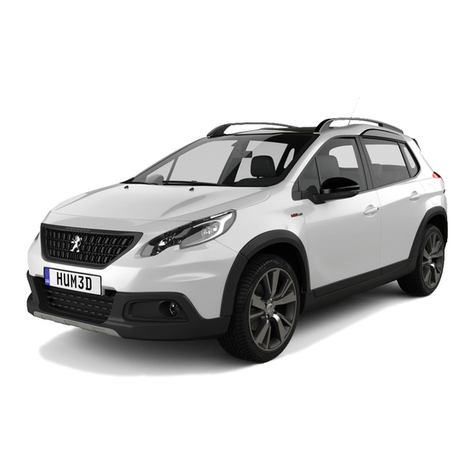
PEUGEOT
PEUGEOT 2008 User manual
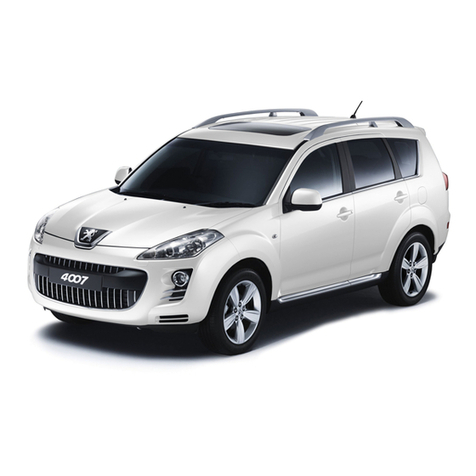
PEUGEOT
PEUGEOT 4007 User manual
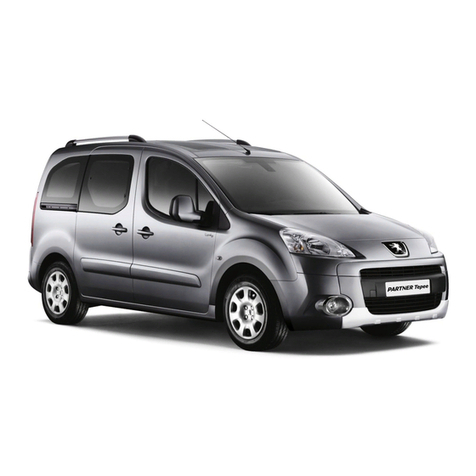
PEUGEOT
PEUGEOT PARTNER Tepee User manual

PEUGEOT
PEUGEOT RCZ User manual
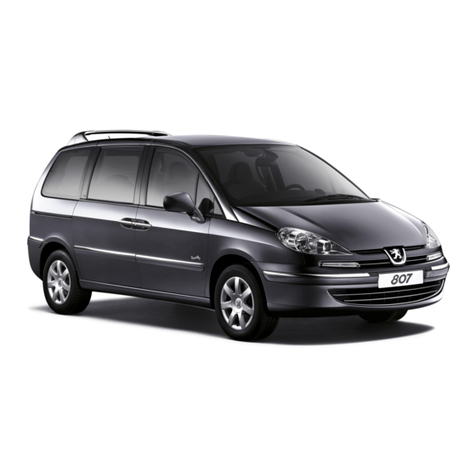
PEUGEOT
PEUGEOT 807 User manual

PEUGEOT
PEUGEOT 407 User manual
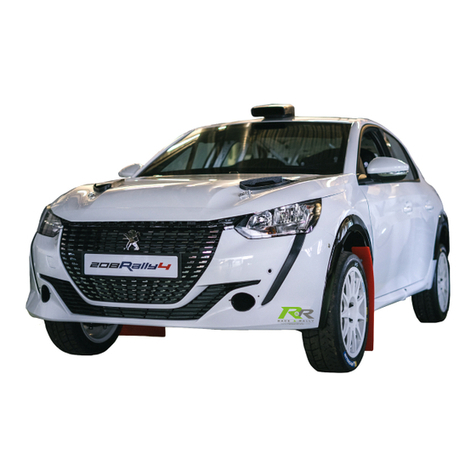
PEUGEOT
PEUGEOT 208 Rally 4 2021 User manual
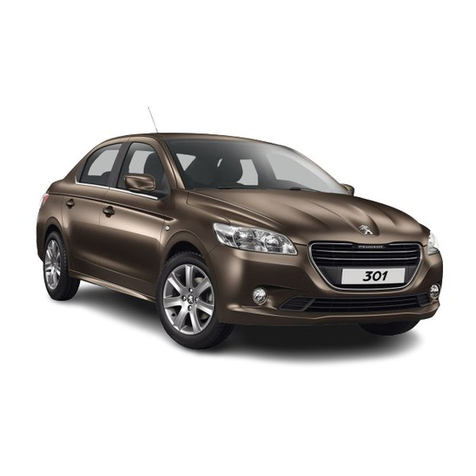
PEUGEOT
PEUGEOT 301 User manual

PEUGEOT
PEUGEOT 308 SW User manual

PEUGEOT
PEUGEOT 3008 User manual
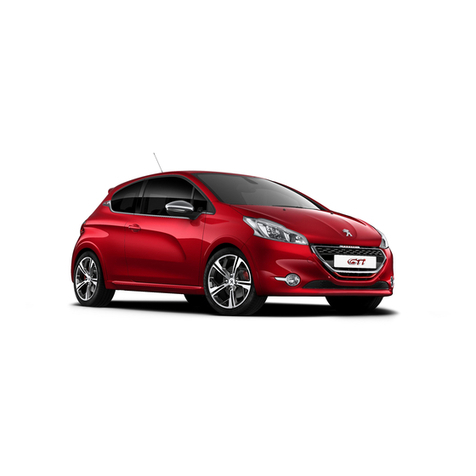
PEUGEOT
PEUGEOT 208 User manual

PEUGEOT
PEUGEOT 108 User manual

PEUGEOT
PEUGEOT Boxer User manual
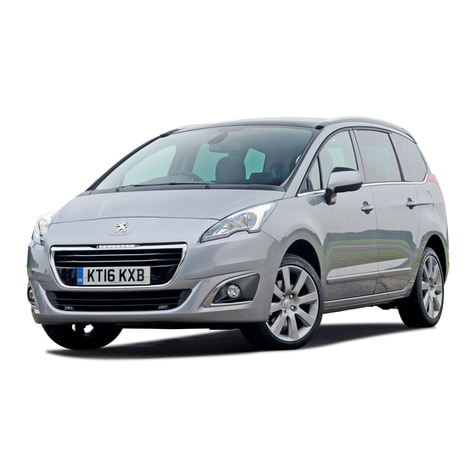
PEUGEOT
PEUGEOT 5008 User manual

PEUGEOT
PEUGEOT 206 CC User manual

PEUGEOT
PEUGEOT 205 Cabriolet User manual

PEUGEOT
PEUGEOT 508 User manual
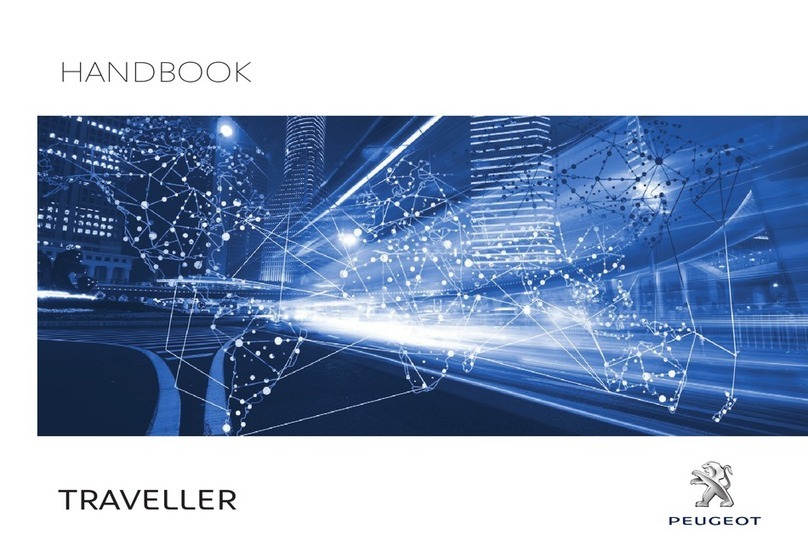
PEUGEOT
PEUGEOT traveller User manual
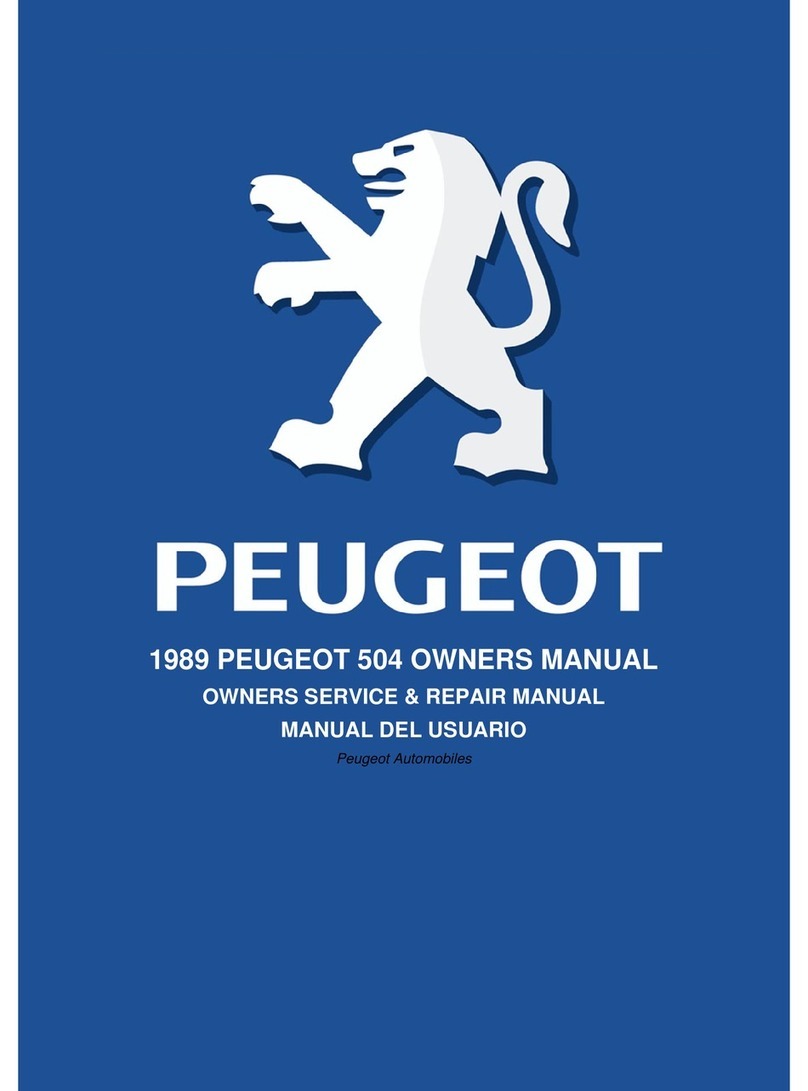
PEUGEOT
PEUGEOT 504 User manual
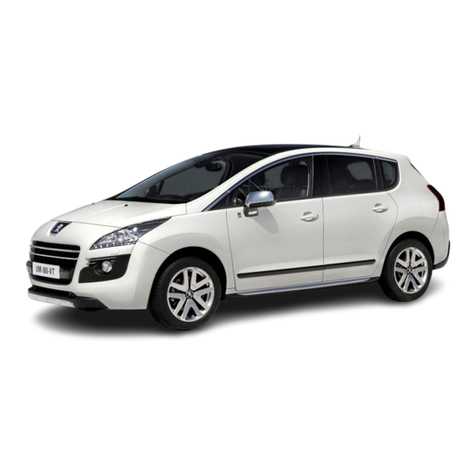
PEUGEOT
PEUGEOT 3008 HYbrif4 User manual
